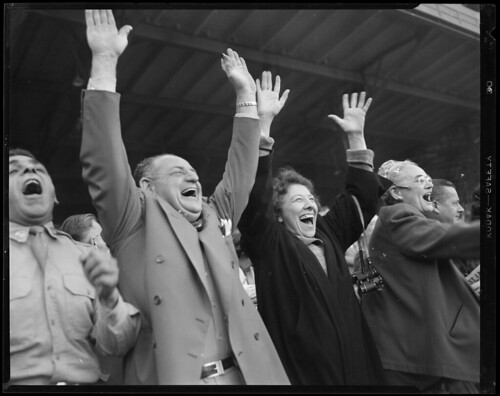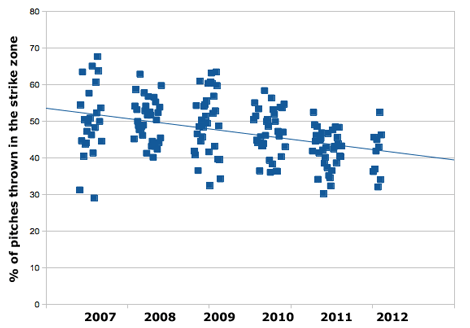But now, they are worried, & not necessarily in the ways they’ve worried in past seasons, many of which featured outstanding pitching performances that couldn’t be converted to wins because of a weak offense. It’s true, the offense still has deficiencies; the fans still worry about the hitting at second base & shortstop, & there’s quite a brouhaha about who’s playing first (in a take-off on the old Abbott & Costello routine)—this latter issue is too complicated to address in the current post.
& yes, they worry—with justification—about the team’s defensive abilities (after all, a team built on pitching needs to have reliable fielders at the very least); questions in that regard surround much of the infield &, depending on who you ask, either one-third or two-thirds of the starting outfield.
But that isn’t the worry: the worry is Tim Lincecum.
Now I realize that Beer League Box Score’s select group of readers includes people who actually know very little about baseball, so I’m going to include some generally we3ll-known background. Lincecum is one of the Giants three ace starting pitchers (along with Matt Cain & Madison Bumgarner.) Since he broke into the National League with the Giants in 2007, Lincecum has been one of the most dominant pitchers around. He won the Cy Young award as the best National League pitcher in both the 2008 & 2009 seasons, & he was a crucial player in the Giants 2010 championship year. Last year, for the most part, Lincecum continued to be a formidable pitcher in a season the overall proved disappointing for the Giants.
& then came 2012.
The season is now just over half completed, & Lincecum’s traditional stats read as follows: 3 wins, 10 losses, a 6.42 era (worst among all regular starting pitchers in the majors); he’s giving up 1.583 walks & hits per inning, which means he’s pitching with baserunners on a lot. Generally speaking, any figure higher than 1.40 in the WHIP category (walks/hits per innings pitched) is not good, not good at all; his statistic barely ranks him among the top 100 pitchers in this category (obviously, the lower this figure is, the better.) He’s thrown 10 wild pitches, which lead the league (not a category in which you want to lead the league), & he also leads the league in earned runs allowed. Only six of over 550 pitchers have walked more batters than the 50 base on balls Lincecum has allowed.
Fans by their nature require that their passions be fed & watered. In the traditional construct of the fan there needs to be elation & unreasoning hope & rage & blind faith & devotion—& the worry of a lover. The lover wonders in what state of affection he/she stands with the beloved—all future hopes & reveries are posited on this question, & countless reams of sonnets, canzones, odes & various lyrics of every shape & size are predicated on this question. & this is true whether the lover is a poet in the sense of writing the poem or reading the poem (& true whether the “poem” is a poem per se or a film or photograph or drama or dance.)
But even as worry opens up a poetic vista for the loving poet or poet-reader, so it opens up for the fan a poetic vista of statistics & comparisons & arguments & debates. The team is her/his beloved; the player, too, insofar as he is a beloved embodiment of the team. This is very true of Lincecum: not only has he been a major player in the Giants’ recent success (& also has not contributed in any significant negative way to recent failures), but he’s also a player just made for San Francisco: nicknamed “the Freak” because of his unorthodox pitching mechanics & also because of his ability to throw very hard despite being more or less the size of an average Joe (baseball pitchers are notoriously big & tall), Lincecum also earns the nickname with his long hair, his endearingly goofy look, & as evidenced by one “bust,” an apparent affinity for marijuana.

Lincecum is also the underdog: when he came up in 2007 a number of scouts said he was still small to be successful at the major league level, at least as a starting pitcher—there was some talk that he might ultimately make it as a relief pitcher, & that he might even be successful in that role. There was talk that his unorthodox throwing motion would lead sooner rather than later to arm injuries of the most dire sort—of course, all pitchers hurt their arms—the torque on the joints caused by throwing baseball pitches is beyond what the human arm can sustain over the course of years. But in Lincecum’s case, the scouts & experts suggested he’d burn out prematurely.
& he beat those odds, winning the highest honors & a world championship.
But now? He’s a liability to the team. They have a record of 4 wins & 14 losses in his starts this year. While his fellow aces Cain & Bumgarner have performed up to expectation, while a fourth starter, Ryan Vogelsong, is in the midst of a second consecutive strong season, & while even the often vilified fifth starter Barry Zito has pitched well given his overall role, Lincecum has not been himself.
& why? Ah, here’s the worry, here comes the torrent of contradictory statistics, visual evidence, opinions & predictions. Because Lincecum’s pitching has been “confusing.” He will look as dominant as ever for an inning or two, or even three, & then dissolve. Occasionally, the progression works in the opposite direction: a horrifying start, then settling down. But for the most part, when the damage is done, it’s done for good—as you can see from the won-lost records, the damage is usually fatal.
We read advanced statistics that suggest he may be getting “unlucky”—these statistics have to do with the number of batters Lincecum strikes out per nine innings (a complete game, tho he has yet to pitch a full nine inning game this year), the percent of balls that are struck by the batters that become base hits, & even some sophisticated adjustments of more basic stats like earned run average. In general, these statistics tend to be effective at predicting performance. But we have the visual evidence too. I’ve watched several Lincecum starts, & tho I’m very much a layman, I have watched baseball for almost 50 years, & I can testify that a high percentage of the hits he’s giving up aren’t “lucky”—they’re hit solidly (& in many cases, “solid” is an understatement.)
The current theory is that the problem is exclusively mental, which in fact may be the most disturbing possibility of all. Speaking of baseball & poetry: the most lyrical of baseball writers, Roger Angell, wrote about Pittsburgh Pirates pitcher Steve Blass in Angell’s fine collection titled Five Seasons. The essay (titled “Gone for Good”) on Blass is beautifully written, based on time spent Angell spent with Blass right after his career came to a premature end when he became inexplicably able to pitch effectively following the 1972 season. At this point Blass had pitched eight years in the majors & while not a dominant pitcher of Lincecum’s stature, he’d been quite successful, & had pitched with noteworthy effectiveness when the Pirates defeated the favored Baltimore Orioles—just one year removed from their dismantling of the vaunted Cincinnati “Big Red Machine” Reds—in the 1971 World Series; in fact, Blass finished second to the great Roberto Clemente in the most-valuable player voting. But a year & a half later, he could barely throw strikes, & by the 1970 season, he was out of baseball. Some have referred to this collapse, which has affected a few other pitchers in recent memory (Mark Wohlers, Rick Ankiel & Dontrelle Willis) as “Steve Blass Disease.”
 It’s a mystery, a true mystery. It’s interesting as I watch Lincecum’s season to think of Angell’s writing in “Gone for Good”; Angell in a sense poeticizes the condition—he makes it lyrical, the story of a good man beset by forces beyond his control; currently, Lincecum’s condition is quantified: statistics are brought to bear from all angles: he’s completely lost it, & figure x proves this; he’s just unlucky, as demonstrated by figure y; etc. Of course, as the season has progressed, the continued visual evidence & traditional statistics, with all their shortcomings, are more & more brought to bear on the situation.
It’s a mystery, a true mystery. It’s interesting as I watch Lincecum’s season to think of Angell’s writing in “Gone for Good”; Angell in a sense poeticizes the condition—he makes it lyrical, the story of a good man beset by forces beyond his control; currently, Lincecum’s condition is quantified: statistics are brought to bear from all angles: he’s completely lost it, & figure x proves this; he’s just unlucky, as demonstrated by figure y; etc. Of course, as the season has progressed, the continued visual evidence & traditional statistics, with all their shortcomings, are more & more brought to bear on the situation.But there is no answer—there’s only worry. This worry builds a world & a narrative. The next episode in that narrative—not counting the banter that will continue on various Giants blogs, chat groups & other forums in the interim, is his next start on Saturday in San Francisco against the Houston Astros. The Astros are a weak team; San Francisco’s ballpark, with its generous dimensions & its relatively cool summer climate, is forgiving to pitchers. An effective start on Saturday won’t end the worry—that has a life of its own, & in fact may complicate it. What does it mean? After all, it was only the Astros. Contrariwise, if he pitches ineffectively, it was also only the Astros & in favorable conditions. The worry narrative morphs again—like the most dire La Belle Dame Sans Merci poem, its lyricism turns to the macabre & the dark.
All images link to their source
Initial image of Tim Lincecum pitching in 2009 is from Wiki Commons, & is licensed under the Creative Commons Attribution-Share Alike 3.0 Unported license by Wiki user
Acordova.
Fans Cheering at the Ballpark by Leslie Jones, from the Boston Public Library. More info here.
Image of Petrarch & Laura is from Wiki Commons; photo of Affresco di Petrarca e Laura, Casa del Petrarca by Wiki users Sandra Cohen-Rose and Colin Rose is made available under the Creative Commons Attribution 2.0 Generic license.
Second photo of Tim Lincecum (also from 09) is is licensed under the Creative Commons Attribution 2.0 Generic license by Wiki user SD Dirk on Flickr
A graph showing Lincecum's percent of pitches in the strike zone over time; as I understand it, this originated on the Fangraphs site, but later showed up both on SBNation & the McCovey Chronicles
Photograph of Steve Blass from the Sports Illustrated Vault
Five Seasons by Roger Angell
Frank Dicksee The Redgirl & the Knight, 1890, from Wiki Commons





No comments:
Post a Comment
Comments are moderated, so please play nice!